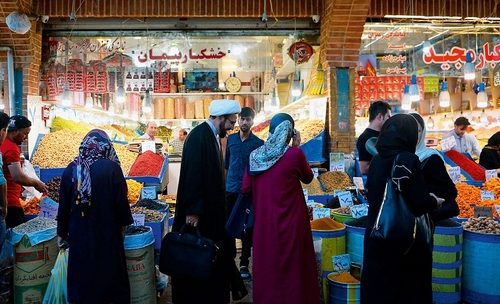May 18, 2020
Oil price drop brings more economic challenges for Iran
On April 20, oil price futures went below $0 for the first time in history. This drop was caused by the decrease in demand due to the coronavirus pandemic, as people abided by stay at home orders and there was a shutdown of transportation—including air travel—around the world. Other causes in the oil price drop were associated with oversupply in the oil market and a late oil production cut by OPEC member countries. Though the oil price crash isn’t as bad as it seems, it sends a signal to expect oil price drops in the future. Such an eventuality would hit oil-exporting countries the most, which is why they need to update their budget plans and cut some of their oil revenue dependent costs.
Iran was the third and fourth-largest oil producer among OPEC countries in 2018 and 2019, respectively. Due to US sanctions, Iranian oil exports were cut by ninety percent from 2.5 million barrels per day in 2018 to 254,000 barrels per day in 2020. The dwindling oil revenue has imposed several problems for the Iranian economy over the past two years. The Iranian economy shrank by 4.9 percent and experienced a high inflation rate of 26.9 percent in 2018 with the reintroduction of US sanctions. With more restrictions imposed on Iran by the US—along with the mismanagement and corruption of the Iranian government—the inflation rate increased to 34.8 percent from March 2019 to March 2020 and the GDP of the country decreased by 7.6 percent from March 2019 to December 2019. It is expected that the updated figures for the Iranian economy will show even more negative GDP growth due to the effects of COVID-19.
The deteriorating Iranian economy has dealt with the economic impacts of the coronavirus since March, when the virus started to spread around the country. The coronavirus imposed both demand and supply shocks to Iran’s fragile economy; many businesses shut down and people stayed home to prevent the spread. The government allocated $305 million to support those who lost their jobs. The rise in unemployment in the last months imposed high costs on the government at a time when it was unlikely to have sufficient reserves from previous years to address these challenges. Furthermore, the prolonged shutdown in Iran may force four million workers jobless, increasing the official unemployment rate from 10.6 percent in spring 2020 to above twenty-six percent. These increasing costs, as well as not having enough funds to cover the expenses, pushed the Iranian government to reopen its economy in mid-April despite public health experts’ warnings of the human cost.
In this backdrop, the sharp oil price drop on April 20 was the worst thing that could have happened to Iran’s fragile economy. In the budget for the new Iranian year (March 2020 to March 2021), thirty-eight percent of the government revenue was expected to come from oil exports. It is very unlikely that the country could make up the oil revenue from other sources, not to mention that the expected tax revenue will be hurt, as well. In the 2020 budget bill, the exportation of one million barrels per day at a price of $50 was predicted. This prediction, now, seems to be a fantasy for this year.
The demand shock caused by the pandemic decreased both Iranian oil exports and oil prices. At the time of writing this piece, Iranian crude oil prices are trading below $18 and it is expected to fall further in the following months. The difference between the predicted oil price in the budget bill and the actual price suggests that Tehran could lose over sixty-four percent of the expected revenue from exporting crude oil. This massive decrease in government revenue alongside increasing costs, such as stimulus packages offered to support businesses and workers, leaves the government in a very tight spot. However, Iran has several policies at its disposal that it can put to use.
The first possible action would be to cut some expenditures expected in the budget bill, including the capital budget or development budget and subsidies. Over ten percent of jobs—consisting of around 2.3 million jobs—are highly dependent on government revenue. Most of these jobs are in services, like education, public administration, and defense, and government procurement covers more than fifty percent of their incomes. Moreover, the government supports thirty percent of the workers—about seven million jobs—by compensating over thirty percent of their costs through subsidies. The government procurements and subsidies leave more than nine million workers at risk of losing their jobs due to the sharp drop in oil prices and the impacts of COVID-19 on government revenue.
On top of cutting some government expenditures, they will increase the official exchange rate to, partially, compensate for the loss of the oil revenue. The official exchange rate is around 42,000 rials per dollar while the unofficial price, which is traded in the market, is about 150,000 rials per dollar. The difference between official and unofficial rates justify the increase of the official rate by the government. However, increasing the official exchange rate will increase both the unofficial rate and inflation.
Additionally, increasing the official exchange rate and cutting some government expenditures seems unlikely to cover costs in the following months. The government would be tempted to print more money, which would not have any other result but to raise the inflation rate.
Similarly, a recent proposal to slash four zeros, agreed on May 4 by parliament —thereby replacing the rial with the toman—won’t make any difference in the money supply. As President Hassan Rouhani stated, the change is to make transactions easier and will not have any significant impacts on the economic situation.
The best possible solution to mitigate the economic challenges of the Iranian economy during this pandemic seems to be getting loans from international organizations like the International Monetary Fund (IMF) and the World Bank. Iran submitted an application to the IMF for a $5 million loan on March 6. Tehran could use this loan to address the economic challenges facing Iran without causing further problems to the economy. Providing Iran with international loans and funding, along with the international supervision to help the country address most needed challenges, could help Iran and the Middle East avoid getting into a deepening recession.
Despite Iran’s desperate need to get these loans, the US plans to block such funding to Iran, claiming that Tehran would use these loans for its destabilizing regional activity. If Iran cannot not access these loans, the country will face a higher inflation rate and more currency devaluation in the future. Countries need to work with each other to stop the spread of the virus and open businesses sooner. This pandemic has shown that addressing this challenge requires a high level of international cooperation.
The United States needs to take appropriate measures to help other nations, including Iran, to prevent the further spread of the virus and not push those nations into a deepening recession. International monitoring and providing aid to nations in need guarantees control over the spread of COVID-19 and will allow the world economy to recover sooner rather than later.
Ebad Ebadi is a PhD candidate in economics at George Washington University, where he studies the economic impacts of the US sanctions on Iran. Follow him on Twitter: @ebadi_ebad.
Image: A woman looks at an electronic board showing stock prices, following the outbreak of the coronavirus disease (COVID-19), at Tehran Stock Exchange in Tehran, Iran, May 12, 2020. WANA (West Asia News Agency)/Ali Khara via Reuters


